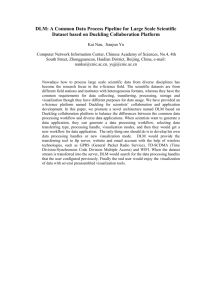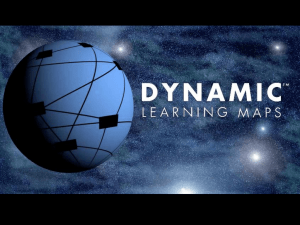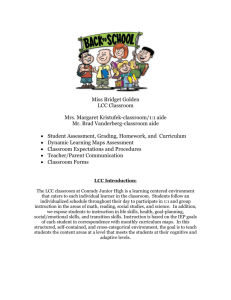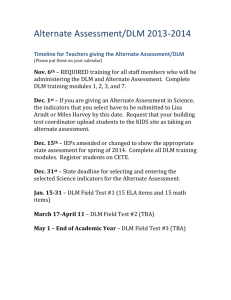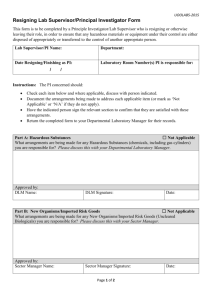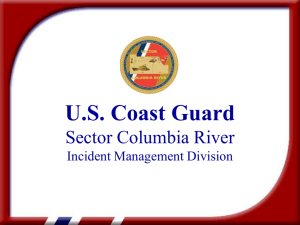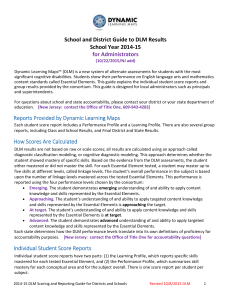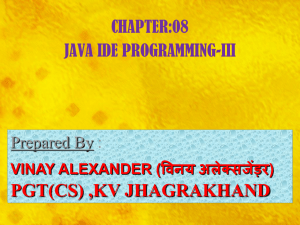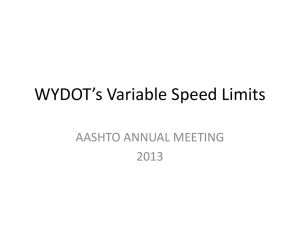abstract
advertisement
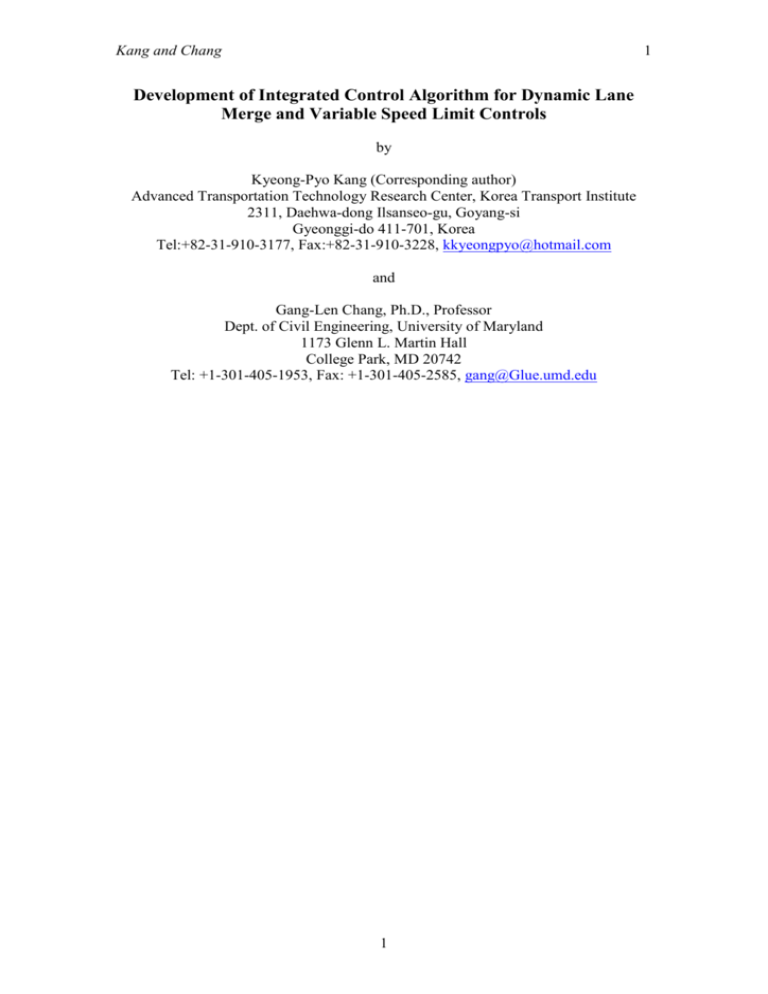
Kang and Chang 1 Development of Integrated Control Algorithm for Dynamic Lane Merge and Variable Speed Limit Controls by Kyeong-Pyo Kang (Corresponding author) Advanced Transportation Technology Research Center, Korea Transport Institute 2311, Daehwa-dong Ilsanseo-gu, Goyang-si Gyeonggi-do 411-701, Korea Tel:+82-31-910-3177, Fax:+82-31-910-3228, kkyeongpyo@hotmail.com and Gang-Len Chang, Ph.D., Professor Dept. of Civil Engineering, University of Maryland 1173 Glenn L. Martin Hall College Park, MD 20742 Tel: +1-301-405-1953, Fax: +1-301-405-2585, gang@Glue.umd.edu 1 Kang and Chang 2 ABSTRACT To facilitate the merging maneuvers and minimize potential collisions during the dynamic late merge (DLM) operations, this study has developed a system control process that can integrate the variable speed limit (VSL) with the DLM so as to maximize the total effectiveness. The proposed integrated control process has used the optimal VSL control model as a supplementary strategy of the entire DLM operations, and coordinated the sequence of variable message signs (VMS) generated from the DLM and VSL algorithms. From the simulation experiment, the integrated algorithm of the DLM and VSL controls has shown to respond well to time-varying traffic conditions and yielded more work-zone throughputs than the DLM control without VSL. It has also demonstrated that the integrated control results in an increase in the average speed and a decrease in the speed variation. In particular, the VSL effect is evident as a supplementary role for the dynamic merge control. 2 Kang and Chang 3 INTRODUCION Contending with congestion and incidents in highway work zones has long been recognized as one of the priority tasks of most highway agencies. An increasingly popular practice for work zone operations is to recommend or enforce a reduced speed limit and merge control via variable message signs, which may or may not respond to the time-varying traffic demand. To properly respond to traffic conditions and also to increase compliance rate of drivers, traffic professionals have recently explored the use of dynamic late merge (DLM) and variable speed limit (VSL) controls in place of the conventional operational strategies. In addition, most field study results and simulation experiments have indicated that properly regulating traffic flows with DLM and/or VSL can indeed reduce the potential risk of having rear-end collisions in highway work zones (1-4). However, field implementations of DLM and VSL have also revealed that their independent operations may not best achieve the potential effectiveness. Besides, most existing practices have been designed in response to traffic safety concerns, not for improving the operational efficiency, such as maximizing the throughput, or minimizing the average delay of vehicles traveling through the entire highway segment plagued by the work-zone incurred traffic queue. Hence, how to best operate the DLM and VSL controls under various congested work-zone conditions so as to maximize their compound effectiveness remains an imperative issue. This study focuses on exploring the potential of integrating those two control strategies in work-zone operations and comparing its effectiveness with each individual control. Section 2 summarizes the key control features, including their compatibility and potential implementation issues. A detailed description of control 3 Kang and Chang 4 algorithms for those two models is available elsewhere (5-7). A set of procedures for integrated operations is proposed in Section 3. Numerical experiments for performance evaluation of an example integrated control system are reported in Section 4. Research results and on-going studies are also discussed in the last section. OVERVIEW OF THE DLM AND VSL CONTROL STRATEGIES DLM control based on the optimal control threshold model The DLM control strategy is to dynamically direct drivers’ merging actions, based on detected traffic conditions and the proper control thresholds. For example, when traffic data were detected to exceed the specified threshold (i.e., congested level), the DLM control will function similarly to the static late merge (SLM) control and display their merging messages (e.g., “USE BOTH LANES” / “TO MEREG POINT”) at proper upstream locations. During the uncongested period, it will be at the inactive state, and essentially perform like the conventional merge or static early merge (SEM) control (e.g., “RIGHT/LEFT LANE CLOSED” or “MERGE HERE”) (1-2). In review of the operation characteristics and traffic conditions of the early and late merge controls, it is clear that each of these two controls has its most applicable traffic conditions. Hence, the best DLM system is to activate one of these two merge controls, based on the optimal set of control thresholds computed from detected traffic conditions. Figure 1 illustrates these two control thresholds (i.e., CT 1 and CT 2), which are the criteria for the system to select the SEM, SLM, or SLM+ 4 Kang and Chang 5 control, based on their relations with the detected traffic states. Each of these criteria is briefly discussed below. CT 1 is to reflect the state that traffic remains at free or moderate flow condition, where drivers on the open lane are nearly unimpeded by those changing from the closed to the open lanes when the DLM system activated the SEM control. CT 2 is to indicate the boundary of the congested traffic state at a work zone, over which the open lane cannot provide sufficient merging space for vehicles on the closed lane to merge onto the open lane under the DLM operation. Thus, some other control measures (SLM+ ) such as speed control to the approaching flows will be needed. To maximize the effectiveness of both merge controls (i.e., SEM and SLM), the authors have developed an advanced DLM system based on those optimal merge control thresholds (i.e., CT 1 and CT 2). The proposed optimization model selects the maximization of the throughputs as the control objective. A more detailed description for computing the optimal control thresholds is available in the literature (5). Optimal VSL control The VSL control strategy aims to properly respond to time-varying traffic conditions with a dynamically adjusted set of speed control that covers the entire upstream subsegments impacted by the work zone operations. However, as reviewed in the literature (8-10), most existing VSL related systems suffer the following two common limitations in their applications: 5 Kang and Chang 6 Main control objectives are proposed in response to traffic safety concerns, but not for operational efficiency, such as to maximize the throughput from a work-zone segment or to minimize the average delay for vehicles traveling through the entire highway segment plagued by the work-zone incurred traffic queue; and Core control algorithms do not intend to minimize traffic congestion by dynamically setting the optimal speed limits and coordinating them based on their spatial relations. The authors have proposed an optimal VSL control model for addressing the above limitations, based on the evolution of dynamic traffic states and macroscopic traffic characteristics (6-7). The proposed VSL system has the following features: adopting the maximization of work-zone throughput as its control objective which is subjected to some embedded safety related constraints; computing a sequence of optimal transition speeds for approaching vehicles, based on dynamic interactions between the work zone traffic flows and those in upstream highway segment; and dynamically adjusting the set of displayed optimal speed limits, based on the detected speed distributions and flow rates so as to effectively respond to potential demand variation and non-compliance behavior of some drivers. As shown in Figure 2, the proposed VSL system consists of sensors, variable speed limit signs, variable message signs and a central processing unit to execute control actions. The variable message signs (VMS) are used to inform drivers of the traffic condition ahead and to display the enforced speed limit based on the VSL control strategies. 6 Kang and Chang 7 For on-line system applications, some non-linear traffic flow relations have been approximated with linear functions but updated continuously from on-line detector data. To reflect the need of improving traffic safety, a set of speed boundaries has been given as model constraints. Moreover, the normal deceleration rate has been used in determining the length of each subsegment, which is to ensure that drivers can reduce their speeds at an acceptable braking rate in response to those displayed VSL signs. Model components and their mathematical expressions are described in detail in the reference (7). Critical issues for integration To best integrate DLM and VSL, one needs to examine their compatibility and implementation priority especially with respect to the operational efficiency and traffic safety. For example, Are the control objectives of both systems compatible or not? Since the objective function of both proposed control systems is to maximize the total throughputs over the upstream subsegments, it is undoubted that one can operate both systems in a compatible format. Has any conflict factor embedded in those two control processes that may degrade their integrated performance? Note that the proposed DLM control is designed to guide drivers’ merging actions between the open and closed lanes, while the VSL strategy is to control their approaching speeds to both lanes, regardless of the merging maneuvers. Thus, their model structures do not have any conflict components to prevent their integrated operations. 7 Kang and Chang 8 How to determine the implementation priority between DLM and VSL? Since the foremost objective of the work zone control is to guide drivers over the lane-closure segments with proper merging maneuvers, one shall view DLM as the direct and the first level control. The VSL, designed for the speed control, can be viewed as a supplementary strategy for improving the safety and the efficiency during merging operations. DEVELOPMENT OF THE INTEGRATED ALGORITHM As mentioned previously, the purpose of an integrated DLM/VSL operation is to dynamically control drivers’ merging activities and speeds, with the optimal merging control thresholds and speed limits based on detected traffic conditions. Since there exists no compatibility and implementation issues between those two algorithms, this study has proposed the following procedures for their integrated operations. Step-1: Compute the potential maximum queue length The purpose of this step is to approximate the maximum queue length, based on the difference in maximum flow rates between the upstream segment and the work zone, as the computed queue length will be used as the target control segment for the DLM and VSL operations. If the actual traffic queue caused by the work zone operations exceeds the target segment, then one should extend the target control boundaries to cover the entire roadway segment potentially impacted by the work zone traffic queue. 8 Kang and Chang 9 Step-2: Set the initial speed boundaries for the VSL control This step is designed to set an initial speed boundary that reflects the free flow speed for each subsegment i. This boundary is designed to prevent the optimal speed limit of subsegment i from exceeding the boundary of its upstream subsegment (i+1). Thus, a set of optimal VSL, based on these speed boundaries, will enable drivers to smoothly adjust their speed when approaching the work zone. Such speed boundaries will be revised dynamically by the central control unit, based on the detected speed data. Step-3: Locate the DLM and VSL trailers The locations of DLM and VSL trailer set should be determined on the basis of the average decelerating rate of drivers when they perceive each displayed VSL or DLM sign. By using a normal deceleration rate (e.g., a=3.3mph/sec), one can divide the target segment into n subsegments. This is to ensure that when perceiving the DLM and VSL signs, drivers need not to experience an uncomfortable and unsafe deceleration rate. Step-4: Initialize all PCMS and VSL systems The integration system is initialized by setting VSL with a set of initial speed boundaries and DLM to be at the Early Merge (or conventional static merge) state. Such an initialization can be done only when the lane-closure operations are started under the free flow traffic condition. Each sensor should also be activated for measuring the traffic data (e.g., volume and speed) at this initialization stage. 9 Kang and Chang 10 Step-5: Execute Dynamic Late Merge control The proposed DLM control can be executed by identifying the detected traffic states (e.g., moderate, congested, and heavily congested traffic conditions), and then followed by displaying the optimal merging directions on PCMS (Portable Changeable Message Sign) or VMS (Variable Message Sign). Step-6: Update the speed boundaries One can also employ the measured traffic data (i.e., speeds) for the DLM control to update the speed boundaries (see Step-2). Step-7: Execute the optimal VSL control model The final step is to optimize a set of speed limits over all subsegments during each control time interval (e.g., 1min.). As mentioned in Step-1, if the actual queue length is longer than the projected maximum queue length, then go to Step-1. Otherwise, the system shall repeat Steps 5, 6, and 7 with the data detected from the sensors. Figure 3 presents the principal steps for integrated operations of the DLM and VSL controls, including the interactions between sensors, DLM, VSL, and the feedback process. The entire process is designed to ensure that the VSL can always reflect the traffic states controlled by DLM and take into account the embedded safety constraints (e.g., speed boundary and sign locations). 10 Kang and Chang 11 EVALUATION OF THE INTEGRATED CONTROL Design of experiments To simulate the on-line work-zone control with the proposed integrated operations (see Figure 3), this study has designed the experimental scenarios with CORSIM-RTE (CORridor SIMulation – Rune Time Extension), a program designed to capture the interactions between the simulated vehicles and the execution of the integrated DLM/VSL control under the time-varying traffic conditions. Figure 4 illustrates an example work-zone system for simulation experiments, in which one left lane was closed on a two-lane highway segment, and drivers are all assumed to cooperate with the displayed messages. Performance evaluation The evaluation task is focused on comparing the integrated control (called DLM/VSL) with the DLM control (called DLM) and the DLM control by Mn/DOT (called Mn-DLM) same as those conduced in the previous study (2). The performance evaluation includes both the operational efficiency and traffic safety. The experimental results on those two regards are summarized below. Operational efficiency The operational efficiency of the target work zone system (see Figure 4) is evaluated with two measures of effectiveness (MOE), the work zone throughput and average speed. 11 Kang and Chang 12 Figure 5 compares the work zone throughputs between those three control strategies under the time-varying traffic conditions. The DLM/VSL and DLM controls produced 1750 vphpl and 1670 vphpl throughputs, respectively under the average volume of 2000 vph (see Figure 5a); and 1870 vphpl and 1720 vphpl, respectively under the average volume of 2400 vph (see Figure 5b). These results indicate that with the complemental VSL control, the DLM operations can indeed yield a more throughput than that when it works alone. Figure 6 represents the average speeds detected from the upstream subsegments (e.g., Links 1 to 5, see Figure 4). Overall, there exists no significant difference in the average speeds between the DLM/VSL and DLM controls. It seems that the implementation of VSL does not contribute to any reduction in the average flow speed, which instead may actually improve the average flow speed on the upstream subsegments (e.g., Links 1 to 3 at Figure 6a, and Links 1 and 4 at Figure 6b). Traffic safety Traffic safety is one of the most important issues during work-zone operations, especially under the congested and fluctuating traffic conditions. Under the integrated operations, the VSL control is expected to help drivers properly adjust their speeds on their merging and lane-changing maneuvers so as to increase the performance of the DLM control. The simulation results with respect to traffic safety are summarized below. Figure 7 compares the patterns of speed changes detected over the upstream subsegments (e.g., Links 1 to 3, see Figure 4) under the time-varying traffic 12 Kang and Chang 13 conditions of average volume equal to 2000 vph. As highlighted in Figure 7a, the average speeds drop or changes drastically and inconsistently under the DLM control. In contrast, Figure 7b shows that under the DLM/VSL control, the speeds on those links at a relatively smooth and consistent rate, despite the fluctuating traffic conditions. During the example operational period, their numerical comparison of speed changes between the initial and latter time intervals is reported in Table 1. Under the other time-varying traffic conditions of average volume equal to 2400 vph, Figure 8 compares the patterns of speed changes detected over three upstream subsegments (i.e., Links 1 to 3) during the specified time intervals (e.g., highlighted circles). Figure 8a shows the fluctuating and inconsistent pattern of speed changes under the DLM control. Under the DLM/VSL control, however, Figure 8b indicates that their average speeds are maintained smoothly and consistently, with corresponding to the time-varying traffic condition. Likewise, the numerical example of speed changes during the specified time intervals is also compared in Table 1. As compared in Figures 8(a) and (b), particularly, it should be noted that as the simulation time interval increases, the DLM/VSL still maintains higher speeds (approx. 10.0 mph) around the merge point (i.e., Link 1) than those (approx. 5.0 mph) under the DLM control. This indicates that the integrated control retards the impacts of traffic congestion and merging conflict on the merge point by the effective speed control of VSL, during the work zone operation period. Consequently, the integrated control is expected to help drivers pass the upstream segment of the work zone area with smooth speed changes. This is 13 Kang and Chang 14 supported by the results shown in Figure 9, where the speed variations over the upstream subsegments (i.e., Links 1 to 5, see Figure 6.4.1) are overall lower under the DLM/VSL control than under the DLM control. This result means that the integrated control can mitigate the impacts of the frequently changed merge strategies by DLM on the speed variations, and enhance the performance of the DLM control with the help of VSL. CONCLUSIONS To facilitate the merging maneuvers and minimize potential collisions during the DLM operations, this study has developed a system control process that can integrate the VSL with the DLM so as to maximize the total effectiveness. The proposed integrated control process has used the optimal VSL control model as a supplementary strategy of the entire DLM operations, and coordinated the sequence of VMS messages generated from the DLM and VSL algorithms. From the simulation experiment, the integrated algorithm of the DLM and VSL controls has shown to respond well to time-varying traffic conditions and yielded more work-zone throughputs than the DLM control without VSL. It has also demonstrated that the integrated control results in an increase in the average speed and a decrease in the speed variation. In particular, the VSL effect is evident as a supplementary role for the dynamic merge control. However, it should be mentioned that this type of the advanced control systems cannot guarantee the performance in field applications unless the sufficient number of sensors required for the DLM and VSL control models function properly with respect to their accuracy and reliability. Thus, a further study is to consider the limitations caused by the sensor system in field applications, based on the actual 14 Kang and Chang 15 traffic flow data and the lessons observed from the previously tested DLM systems. One also needs to properly identify the locations of VMS and the displayed messages so as to increase the compliance rate of drivers. 15 Kang and Chang 16 REFERENCES 1. Taavola, D., Jackels, J., and Swenson, T., Dynamic Late Merge System Evaluation: Initial Deployment on US-10, Summer 2003, Minnesota Department of Transportation, 2004. 2. Chang, G. L. and Kang, K. P., Evaluation of Intelligent Transportation System Deployments for Work Zone Operations. Report MD-05-SP, Department of Civil Engineering, University of Maryland (UMCP), Sponsored by Maryland State Highway Administration, August 2005. 3. Lyles, R. W., Taylor, W. C., Lavansiri, D., and Grossklaus, J., A Field Test and Evaluation of Variable Speed Limits in Work Zones, Transportation Research Board Annual Meeting (CD-ROM), Washington, D.C., 2004. 4. Park, Byungkyu and Yadlapati, S. S., Development and Testing of Variable Speed Limit Logics at Work Zones Using Simulations, Transportation Research Board Annual Meeting (CD-ROM), Washington, D.C., 2003. 5. Kang, K. P. and Chang, G. L., Development of an Advanced Dynamic Late Merge Control Model and Algorithm, Transportation Research Board Annual Meeting (CD-ROM), Washington, D.C., 2006. 6. Lin, P. W., Kang, K. P., and Chang, G. L., Exploring the Effectiveness of Variable Speed Limit Controls on Highway Work Zone Operations. In Journal of Intelligent Transportation Systems, Vol. 8 (3), July 2004. 7. Kang, K. P., Chang, G. L., and Zou, N., An Optimal Dynamic Speed Limit Control for Highway Work Zone Operations. In Transportation Research Record 1877, TRB, National Research Council, Washington, D.C., 2004, pp. 77-84. 16 Kang and Chang 8. 17 Wilkie, J. K., Using Variable Speed Limit Signs To Mitigate Speed Differentials Upstream of Reduced Flow Locations. In Compendium of Graduate Student Papers on Advanced Surface Transportation System; Texas Transportation Institute Report SWUTC/97/72840-00003-2. August 1997. 9. Coleman, J. A. et al., FHWA Study Tour for Speed Management and Enforcement Technology. FHWA-PL-96-006. Federal Highway Administration, U.S. Department of Transportation, February 1996. 10. Smulders, S., Control by Variable Speed Signs: Results of the Dutch Experiment. 6th International Conference on Road Traffic Monitoring and Control. 1992. 17 Kang and Chang 18 LISTS OF TABLES AND FIGURES TABLE 1 Comparison of Speed Changes between DLM and DLM/VSL (unit: mph) ---------------------------------------------------------------------- 18 FIGURE 1 Interrelations between the Optimal Control Thresholds (CT 1 and CT 2) -------------------------------------------------------------- 19 FIGURE 2 Configuration of a VSL System ------------------------------------------- 20 FIGURE 3 An Integrated Algorithm of DLM and VSL Controls ---------------- 21 FIGURE 4 Configuration of the Integrated Control System ---------------------- 22 FIGURE 5 Comparison of Work Zone Throughputs under Time-Varying and Congested Traffic Conditions ---------------------------------------23 FIGURE 6 Comparisons of Average Speeds under Time-Varying and Congested Traffic Conditions -------------------------------------------- 24 FIGURE 7 Comparison of Speed Changes over the Upstream Segment (Ave. = 2000 vph) ------------------------------------------------------------25 FIGURE 8 Comparison of Speed Changes over the Upstream Segment (Ave. = 2400 vph) ------------------------------------------------------------26 FIGURE 9 Comparison of Speed Variations over the Upstream Segment under Time-Varying and Congested Traffic Conditions ----------- 27 18 Kang and Chang 19 TABLE 1 Comparison of Speed Changes between DLM and DLM/VSL (unit: mph) Upstream subsegments Link 1 Link 2 Link 3 Figure 7 (operational period) DLM DLM/VSL Initial / Latter Initial / Latter 15.0 / 6.0 22.0 / 13.0 41.0 / 12.0 42.0 / 30.0 27.0 / 29.0 51.0 / 37.0 19 Figure 8 (specified time intervals) DLM DLM/VSL From / To From / To 5.0 / 9.3 10.0 / 11.0 48.0 / 6.0 30.0 / 35.0 41.0 / 42.0 38.0 / 40.0 Kang and Chang 20 Vol. = 0 vphpl Vol. = 2200 vphpl Range available for SEM ? Range available for SLM ? DLM control DLM control SEM SLM + SLM CT 1 CT 2 FIGURE 1 Interrelations between the Optimal Control Thresholds (CT 1 and CT 2) 20 Kang and Chang VMS 21 Sen 1 Sen 2 Sen 3 Sen 4 Sen 5 VSL 1 VSL 2 VSL 3 VSL 4 VSL 5 VSL 6 Central porcessing unit FIGURE 2 Configuration of a VSL System 21 Kang and Chang 22 Step-1: Compute the potential Max. queue lentgh Traffic flow rate between the upstream and work zone Target section controlled by DLM and VSL Step-2: Set the initial speed boundaries Speed data between the upstream and work zone Expected free flow speed of each subsection Step-3: Locate the PCMS and VSL trailers Normal deceleration rate Length of subsection between trailers t=0 Estimated data of upstream and downstream Flow rate Density Step-4 : Initialize all PCMS and VSL messages A Set of initial speed boundaries Early merge state or Conventional static signs t = t+1 t=0 Step-5 : Execute the optimal DLM control Determine the traffic conditions (Moderate, Congested, Heavy congested status) Display the merge strategies to maximize the work-zone throughputs (Early or Late or Traffic Back-up) Step 6 : Update the speed boundaires Changed to cooperate with the DLM control Determined based on the thresholds of each state and location Actual data from the sensors Volume Speed Yes Step 7 : Execute the optimal VSL control Measure the traffic conditions for the determined merge strategy Compute a set of speed limits to maximize the work-zone throughputs Actual queue length Maximum queue length FIGURE 3 An Integrated Algorithm of DLM and VSL Controls 22 No Kang and Chang 23 VSL5 VSL4 Link 5 SPEED LIMIT 65 MPH VSL3 Link 4 VSL2 Link 3 WORK ZONE 45 MPH VSL1 Link 2 WORK ZONE 45 MPH Link 1 WORK ZONE 45 MPH 1000 ft 1 mile 2 miles EARLY MERGE SIGNS LEFT LANE CLOSED 2 MILES LEFT LANE CLOSED 1 MILE TAKE YOUR TURN / MERGE HERE LATE MERGE SIGNS USE BOTH LANES USE BOTH LANES TAKE YOUR TURN / MERGE HERE FIGURE 4 Configuration of the Integrated Control System 23 Kang and Chang 24 Work zone throughputs (a) under the time-varying traffic condition (Ave. = 2000 vph) 2000 Work zone throughput (vphpl) DLM/VSL = 1750 vphpl DLM/VSL 1800 DLM 1600 DLM = 1670 vphpl Mn-DLM 1400 1200 Mn-DLM = 1510 vphpl 1000 800 600 400 200 0 1 4 7 10 13 16 19 22 25 28 31 34 37 40 43 46 49 52 55 58 Time intervals (1 min.) Work zone throughputs (b) under the time-varying traffic condition (Ave. = 2400 vph) 2000 Work zone throughput (vphpl) DLM/VSL = 1869 vphpl DLM/VSL 1800 DLM 1600 Mn-DLM 1400 DLM = 1720 vphpl 1200 1000 Mn-DLM = 1393 vphpl 800 600 400 200 0 1 4 7 10 13 16 19 22 25 28 31 34 37 40 43 46 49 52 55 58 Time intervals (1 min.) FIGURE 5 Comparison of Work Zone Throughputs under Time-Varying and Congested Traffic Conditions 24 Kang and Chang 25 Average speeds over the upstream segment (a) under the time-varying traffic conditin (Ave. = 2000 vph) 70 60 Speeds (mph) 50 DLM/VSL DLM Mn-DLM 40 30 20 10 0 Link 1 Link 2 Link 3 Link 4 Link 5 Upstream subsegment Average speeds over the upstream segment (b) under the time-varying traffic condition (Ave. = 2400 vph) 70 60 Speeds (mph) 50 DLM/VSL DLM Mn-DLM 40 30 20 10 0 Link 1 Link 2 Link 3 Link 4 Link 5 Upstream subsegments FIGURE 6 Comparisons of Average Speeds under Time-Varying and Congested Traffic Conditions 25 Kang and Chang 26 Evolution of speed changes over the upstream segment under the DLM control (Ave. = 2000 vph) (a) 80 2200 Link 1 70 Link 2 Link 3 Time-varying Up. Vol. 2000 1600 50 1400 1200 41.0 40 1000 30 29.0 27.0 800 600 20 15.0 12.0 6.0 10 0 400 Upstream Volume (vphpl) Speeds (mph) 1800 60 200 0 1 6 11 16 21 26 31 36 41 46 51 56 Time intervals (1 min.) Evolutionn of speed changes over the upstresm segment under the DLM/VSL control (Ave. = 2000 vph) (b) 80 2200 Link 1 Link 2 Link 3 Time-varying Up. Vol. 1700 Speeds (mph) 60 50 51.0 40 42.0 1200 37.0 30 30.0 700 22.0 20 13.0 10 0 200 -300 1 6 11 16 21 26 31 36 41 46 51 56 Time intervals (1 min.) FIGURE 7 Comparison of Speed Changes over the Upstream Segment (Ave. = 2000 vph) 26 Upstream Volume (vphpl) 70 Kang and Chang 27 Evolution of speed changes over the upstream segment under the DLM control (Ave. = 24000 vph) (a) 2600 Link 1 Link 2 Link 3 Time-varying Up. Vol. 60 2200 2000 50 Speeds (mph) 2400 1800 48.0 1600 42.0 41.0 40 1400 1200 30 1000 20 800 10 600 400 9.3 6.0 5.0 Upstream Volume (vphpl) 70 200 0 0 1 6 11 16 21 26 31 36 41 46 51 56 Time intervals (1 min.) Evolution of speed changes over the upstream segment under the DLM/VSL control (Ave. = 24000 vph) (b) 2600 Speeds (mph) Link 1 Link 2 link 3 Time-varying Up. Vol. 2400 60 2200 2000 50 1800 40 1600 40.0 35.0 38.0 1400 1200 30.0 30 1000 20 800 10 600 400 11.0 10.0 200 0 0 1 6 11 16 21 26 31 36 41 46 51 56 Time intervals (1 min.) FIGURE 8 Comparison of Speed Changes over the Upstream Segment (Ave. = 2400 vph) 27 Upstream Volume (vphpl) 70 Kang and Chang 28 Speed variations over the upstream segment (a) (Link 1 to Link 5, Ave. = 2000 vph) 35 30 Standard deviation DLM 25 20 15 DLM/VSL 10 Stdev. Under the DLM/VSL control 5 Stdev. under the DLM control 0 1 3 5 7 9 11 13 15 17 19 21 23 25 27 29 31 33 35 37 39 41 43 45 47 49 51 53 55 57 59 Time intervals (1 min.) Speed varation over the upstream segment (b) (Link 1 to Link 5, Ave. = 24000 vph) 40 DLM 35 Standard deviation 30 25 20 DLM/VSL 15 10 Stdev. under the DLM/VSL control 5 Stdev. under the DLM control 0 1 3 5 7 9 11 13 15 17 19 21 23 25 27 29 31 33 35 37 39 41 43 45 47 49 51 53 55 57 59 Time intervals (1 min.) FIGURE 9 Comparison of Speed Variations over the Upstream Segment under TimeVarying and Congested Traffic Conditions 28
